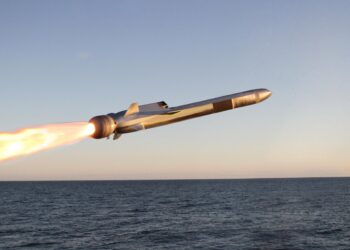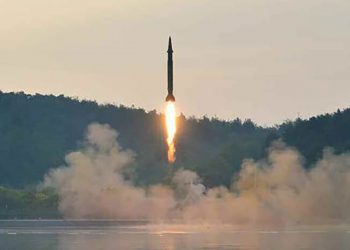Moscow: Four of the first six flight tests of the Bulava-M missile (where “M” stands for morskoi, or naval) were a failure. However, Admiral Vladimir Masorin, commander-in-chief of the Russian Navy, said the Bulava-M (SS-NX-30), a naval derivative of the land-based Topol missile (SS-27), had been approved for mass production.
Did he mean that a batch of missiles would be produced for more tests?
Masorin said the trial period of the Bulava would end in 2008 after two more tests this year. The outcome of these tests is not clear.
In Soviet times, 16 to 20 ground tests and then naval launches were stipulated for each new missile. Americans did likewise when designing the Trident I and Trident II missiles.
The decision of the Bulava designers to begin trials with submarine launches, bypassing ground tests and launches from a sea-based stand, appears opportunistic. This has never been done in naval missile designing before.
Anatoly Perminov, head of the Russian Space Agency, which is responsible for designing and supplying strategic missiles to the armed forces, said the Bulava could be delivered to the navy after at least 12-15 tests.
Yury Solomonov, director and chief designer of the Moscow-based Heat Technology Institute, which had developed the ground-based Topol-M intercontinental ballistic missile (ICBM), said after the second successful launch of the Bulava that the trial had confirmed the design characteristics of the missile's interaction with the submarine. However, he said it needed at least 10 more trial launches.
Trials are held to improve onboard systems, notably microchips, astrocorrection systems, the warhead, the engine, and the like. Flight tests show what degree of the product's exploitation stability can be expected, and also its modernization potential, notably the ability to adjust to a grazing trajectory and increase resistance to external destructive factors. No mathematical models can replace live trials.
The RSD-10 Pioneer mobile ICBM (NATO SS-20 Saber) is a relevant example. It was put on combat duty after all the bugs were cleaned out in 21 successful trials. It was a very good missile. Unfortunately, it was liquidated in keeping with the Soviet-American INF treaty on intermediate- and shorter-range missiles.
Other examples are the RS-12M Topol (SS-25 Sickle) and the RS-12M2 Topol-M (SS-27) missiles, which suffered only one failure in a series of 13 trials.
In the early 1980s, it took 16 missiles to hold the submerged and surface trials of the RSM-52 (SS-N-20 Sturgeon), a solid-fuel ballistic missile designed to carry 10 nuclear warheads, including nine launches from a naval stand and seven from a submarine. The missile was later supplied to six Akula-class (Typhoon) submarines. The missile's warhead comprises ten charges, command systems, and a liquid-fuel multiple warhead dispensing mechanism, as well as air defense evasion systems.
The missile was later overhauled to produce the R-39M Grom (SS-N-28 Bark) missile, which was to be supplied to the Borei-class submarines – the Yury Dolgoruky, the Alexander Nevsky and the Vladimir Monomakh. These strategic submarines were to become the core of Russia's sea-based nuclear forces after the removal of Typhoon-class submarines from combat duty beginning in 2016.
But the Bark project was terminated after the first three unsuccessful launches. The fourth missile was not even launched, although the reasons for the failure of the first three had been removed.
Judging by the logic of Soviet-era trials, the Bulava project should be suspended, if not terminated. Instead, it has been proclaimed ready for mass production. Why?
Some high-ranking Russian officials promised that a cutting-edge submarine would be built and armed with the latest missiles capable of evading any air defense systems, both existing and future ones, by the end of 2008. Failure to keep their word could cost them their high positions and ruin their hopes in the forthcoming presidential election.
The Bulava trials began in December 2003 with a pop-up launch. Sergei Ivanov, then defense minister and now first deputy prime minister, said after the first successful trial: “This is a fourth-generation system we plan to supply to the navy by the end of 2007.”
Many promises were also made with regard to the Glonass, a Russian version of the U.S. Global Positioning System (GPS). Promises must be kept, or you risk losing face.
But hasty decisions, especially when made by bureaucrats, usually have dire – and very expensive – consequences. One of the reasons for closing the Bark project was malfunctions in the missile's control system exposed during the third launch.
However, that system was later mounted on the modernized RSM-54 Sineva (SS-N-23 Skiff) liquid-fuel sea-launched ballistic missile, which was supplied to the navy. It is now considered the best in the world in terms of energy-mass ratio, and, unlike the Bulava, has a huge modernization potential.
The idea of the Heat Technology Institute, which develops mobile ground-based missiles, to adjust the Topol missile for the navy actually boiled down to beginning from scratch. The Institute should at least be given more time to complete the project without undue haste.
Otherwise we may see a repetition of the sad story with the UR-100 (SS-11 Sego) missile, developed at Vladimir Chelomei's design bureau. It underwent a series of simplified trials, with the crucial trials computer modeled, and put on combat duty. But the first live trials showed that it falls thousands of miles short of the target zone. The missiles were removed from combat duty for improvement, followed by a comprehensive program of trials.









